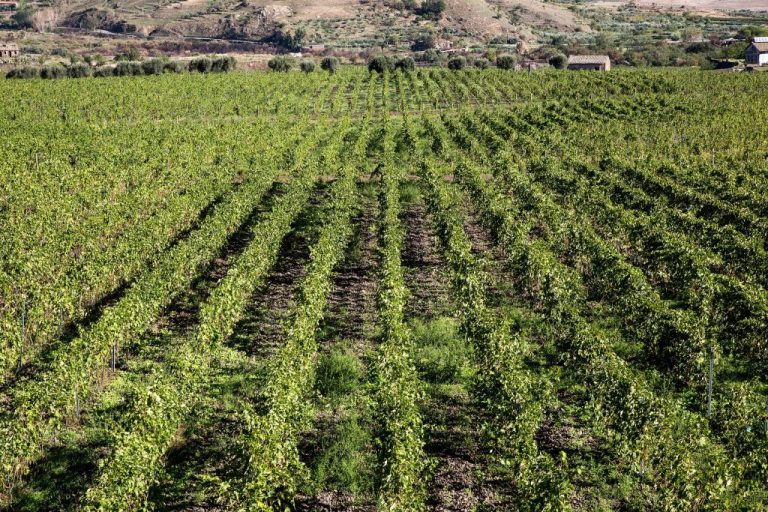Thousand-year history
viticulture on Etna
The wine-growing history of the Etna Volcano is lost in the mists of time. The discovery of wild vines (ampelidae) testifies to the millenary presence of the species on Etna already in the Tertiary period and The poet Theocritus, in the 3rd century BC, speaks of a great diffusion of the vine starting from the 8th century BC.
In the History of Italian wines by Andrea Bacci in 1596, the wines produced on the hills surrounding Catania are mentioned, the goodness of which is attributed to the ashes of the volcano. In the 19th century, the vineyard area on Etna reached 8,000 hectares and, in the mid-1800s, Baron Spitaleri created the first sparkling wines with refermentation in the bottle.
The advent of phylloxera in the early years of the twentieth century led to a reduction in the areas under vines throughout the province of Catania, from 90 thousand to 40 thousand hectares, with a lower incidence along the slopes of Etna and in fact, even today, few if not the only examples of ungrafted vineyards are present and productive in some Contrade of the Etna DOC.
The soils of Etna
Etna is located in the north-eastern part of Sicily, close to the Ionian Sea.
The territory represents one of the most suitable and generous Terroirs in Italy for the quality and variety of wine and wine production which range from the classic method to still wines. The roots of this versatility which is reflected in the plurality of expressions that the same vine can express depending on the area of the volcano where it is grown.
In this sense, Etna can be defined as a stratovolcano formed 570,000 years ago; the eruptions that have occurred over time have profoundly modified both the landscape and the geological structure of the territory, giving rise to a variety of pedological typologies that differ in organic components and not in soil texture. The territory is of basaltic origin, rich in elements such as iron, silica, aluminium, manganese and magnesium, whose concentrations vary depending on the reference district. The texture and structure of the soil diverges considerably within the company’s production area; this involves, together with the climatic variability of the area, a distinct development and maturation of the same vine.

Land with a high content of pyroclastic material, made up of sands and rocks of various grain sizes called “ripiddu”.

Loose, sandy soil with good aeration for the benefit of the plants.

Sandy loam soil of small grain size, rich in complex minerals and with high draining capacity.

Soils rich in microelements and organic substance, good presence of skeleton.

Soils characterized by thin texture, abundance of gravel and little depth.

Il nemico: la Fillossera
The advent of phylloxera in the early years of the twentieth century led to a reduction in the areas under vines, throughout the province of Catania, from 90 thousand to 40 thousand hectares, with a lower incidence along the slopes of Etna and in fact, even today, few if not the only examples of ungrafted vineyards are present and productive in some Contrade of the Etna DOC.
In 1888, the interruption of trade relations with France led to a decline in the export of Etna wines which, in the previous 20 years, had grown considerably. The wine barrels left from the port of Riposto to reach the French, English and South American coasts. But it was certainly the French who were the great beneficiaries of the body and minerality of Etna wines. They imported 85% of the volcano’s entire wine production to give body and life to their wines.
Since the nineties a new spring has begun for the wines of Etna. The fruit of the titanic resistance of a few local entrepreneurs and the foresight of operators from other Sicilian wine-growing areas gives a new impetus to the volcano’s viticulture. We are seeing important signals from international wine critics and the most attentive consumers and thanks to considerable investments the vineyards are returning to greenery in the Contrade of Etna with extensive replanting and the “restoration” of the old and glorious sapling systems.
The landscape changes again: the grape harvesters return to the terraces laboriously created in the lava. The long series of dry stone walls that surrounded the vineyards is restored and each new plant is adapted to modern oenology. The counter-espalier training system is added to the more traditional sapling training and the “mixed” vineyards give way to a new reality that enhances the Etna DOC vines with Nerello Mascalese and Nerello cappella for the red grapes and the Catarratto and Carricante for the white grape varieties.
Etna today offers its precious soils to the production of grapes of extraordinary quality that give elegant wines, with a strong acidity and a minerality that distinguishes current wine production and contributes to the great success of the volcano’s oenology throughout the world.


Unique Terroir
Etna, today, is universally recognized as the Sicilian wine-growing area of excellence. A lava habitat that expands at high altitudes characterized by an extraordinary mineral richness and biodiversity. In this context, there have been vineyards arranged in terraces, interspersed with lava flows since ancient times, creating a unique and unrepeatable terroir which favors particular longevity for the vineyard. There are rare exceptions which include over one hundred year old ungrafted vines which have also survived the advent of phylloxera.
Geology of the Volcano
From a geological point of view, Etna is a productive context that we can consider “young”. Its complexity is mainly due to the fact that the area is capable of providing highly valuable minerals. The extreme youth of the soil in fact makes it rich in elements such as iron, silica, aluminium, manganese and magnesium. The soils are characterized by basaltic rocks, with a silicon concentration of more than 60%. The organic substance content is high. The porosity of the substrate rocks is high and guarantees a constant supply of water to the plants. The high thermal conductivity also guarantees large temperature variations between day and night.


Terroir climatology
It is said that the climate here is not Sicilian, Continental or Mediterranean, but “ETNEO”
We can say that Etna has “three climates”: Montano – Alpine / Xeric – Mediterranean / Variations of the previous points
The “prominence” of Etna ensures that different microclimates are created depending on the side being analyzed on the basis of the following macro variables:
- Orientation (Ex. North – Ex. Nebrodi)
- Influence of the sea (NE-E slopes)
- Altimetry
- Area (Known localized effects: E.g. frosts in the Pietramarina – Castiglione area)
Slope pedology
The wine-growing area of Mount Etna develops along the foothills on a large basaltic volcanic layer to which is added frequent eruptive activity from both the summit vents and the lateral vents. The original morphologies of the lava flows have been modified by intense pedogenetic processes which have produced thick blankets of soil (e.g. climate). The intense and millenary anthropic activity, of an agricultural nature, has remodeled the slopes with terraces and significant land movements. Thanks to its geomorphological, orographic and topographic characteristics, Etna has various microclimates that differ substantially based on area and altitude.


Endemic ampelography
The ampelographic platform of the Etna area, around the 19th century, included more than 40 different varieties of vines. The post-phylloxera viticultural situation changed drastically in quantity and quality. Veterans of the phylloxera drama of Etna were the Nerello Mascalese, the Carricante, the Catarratto and in a smaller percentage the Minnella and the Nerello Cappuccio. The latter has unfortunately greatly reduced its importance over time, almost risking extinction.
Harvest Timeline
Unico
L’Etna, oggi, è riconosciuto universalmente come il territorio viticolo siciliano d’eccellenza.
Un habitat di natura lavica che si espande ad alta quota caratterizzato da una straordinaria ricchezza minerale e di biodiversità. In tale contesto dimorano, succedendosi da tempi antichissimi, vigneti disposti in terrazzamenti, intervallati da sciare laviche, creando un terroir unico e irripetibile che favorisce particolare longevità alla vigna. Esistono rare eccezioni che contemplano viti ultracentenarie a piede franco sopravvissute anche all’avvento della fillossera.
Da un punto di vista geologico, L’Etna è un contesto produttivo che possiamo considerare “giovane”.
La sua complessità è principalmente dovuta al fatto che la zona è in grado di donare apporti minerali di grande pregio. L’estrema giovinezza del terreno infatti lo rende ricco di elementi come il ferro, la silice, l’alluminio, il manganese e il magnesio. I Suoli sono caratterizzati da rocce basaltiche, con concentrazione di silicio superiore al 60%. Elevato è il contenuto di sostanza organica. Elevata la porosità delle rocce del substrato che garantiscono infatti un costante rifornimento d’acqua alle piante. L’elevata conducibilità termica garantisce inoltre grandi escursioni termiche tra il giorno e la notte.
Si dice che qui il clima non sia Siciliano, Continentale o Mediterraneo, ma «ETNEO»
L’Etna possiamo dire che abbia «tre climi»: Montano – Alpino / Xerico – Mediterraneo / Variazioni dei punti precedenti
La «prominenza» dell’Etna fa in modo che si creino diversi microclimi a seconda del versante oggetto dell’analisi sulla base delle seguenti macro variabili:
- Orientamento (Es. Nord – Es. Nebrodi)
- Influenza del mare (Versanti NE-E)
- Altimetria
- Zona (Effetti localizzati noti: Es. gelate nella zona di Pietramarina – Castiglione)
L’area vitivinicola del Monte Etna si sviluppa in corrispondenza della fascia pedemontana su un grande strato vulcanico di natura basaltica.
Alla quale si aggiunge una frequente attività eruttiva sia dalle bocche sommitali sia dalle bocche laterali. Le originarie morfologie delle colate laviche sono state modificate da intensi processi pedogenetici che hanno prodotto spesse coltri di suolo (Es. clima). L’intensa e millenaria attività antropica, di stampo agricolo, ha rimodellato i versanti con terrazzamenti e importanti movimenti di terreno. Grazie alle sue caratteristiche geomorfologiche, orografiche e topografiche l’Etna ha diversi microclimi che differiscono in maniera sostanziale in base a zona ed altimetria.
La piattaforma ampelografica della zona etnea, intorno all’800 annoverava più di 40 diverse varietà di vitigni.
La situazione viticola post-fillosserica cambiò drasticamente per quantità e per qualità. Reduci del dramma fillosserico dell’Etna furono il Nerello Mascalese, il Carricante, il Catarratto e in percentuale minore la Minnella e il Nerello Cappuccio. Quest’ultimo nel tempo ha molto ridimensionato, purtroppo, la sua importanza, rischiando quasi l’estinzione.
Un habitat di natura lavica che si espande ad alta quota caratterizzato da una straordinaria ricchezza minerale e di biodiversità. In tale contesto dimorano, succedendosi da tempi antichissimi, vigneti disposti in terrazzamenti, intervallati da sciare laviche, creando un terroir unico e irripetibile che favorisce particolare longevità alla vigna. Esistono rare eccezioni che contemplano viti ultracentenarie a piede franco sopravvissute anche all’avvento della fillossera.


































